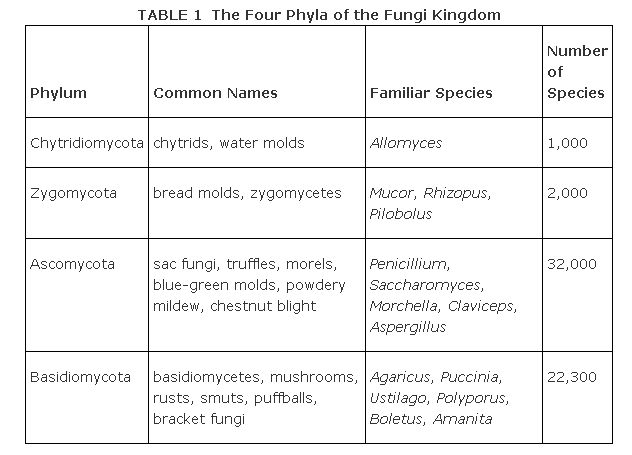A Kingdom Separate from Plants
The fungi (singular, fungus) once were considered to be plants because they grow out of the soil and have rigid cell walls. Now they are placed independently in their own kingdom of equal rank with the animals and plants and, in fact, are more closely related to animals than to plants. Like the animals, they have chitin in their cell walls and store reserve food as glycogen. (Chitin is the polysaccharide that gives hardness to the external skeletons of lobsters and insects.) They lack chlorophyll and are heterotrophic. Familiar representatives include the edible mushrooms, molds, mildews, yeasts, and the plant pathogens, smuts and rusts.
Most fungi are terrestrial, multicellular eukaryotes, the body ( soma) of which is a mass of thread-like filaments called hyphae (singular, hypha), which collectively form amycelium (plural, mycelia). When the fungus reproduces, specialized hyphae pack together tightly and form distinctive fruiting bodies, or sporocarps, from which sexual spores are released. The ordinary edible mushrooms are the fruiting bodies of fungi. Fruiting bodies are temporary structures in the life cycle; the primary body of all fungi is in reality the diffuse, widespreading mycelium.
The fungi reproduce by spores, both asexual and sexual, and the details and structures of the sexual process separate the kingdom into four phyla (see Table 1 ). The zygoteis the only diploid phase in the life cycle; meiosis occurs shortly after the zygote is formed—hence the life cycle is an instance of zygotic meiosis. Chemical signals,pheromones, are exchanged among fungi, especially between pairs preparatory to sexual reproduction.

Fungi are heterotrophs, which release digestive enzymes into their surroundings andabsorb nutrients back. Some fungi are saprobes (saprophytes), as important in decomposition as the bacteria; others are symbiotrophs, living in symbiotic association with plants, animals, protists, and cyanobacteria. Well-known symbioses are: lichens that are associations of fungi and green algae or cyanobacteria;mycorrhizae, associations of fungi and plant roots; and endophytes, fungi and plant leaves and stems. Some fungi are parasites ( fungal pathogens) and responsible for diseases of both plants and animals. Complex life cycles involving one or more hosts have developed between fungal pathogens and their hosts.
The Earth's largest living organism may be a fungus: either the mycelium reported from Washington state that covers 1,500 acres (but probably is disjointed and broken) or the one in Michigan that covers 37 acres (and is estimated to weigh 110 tons—the weight of a blue whale).